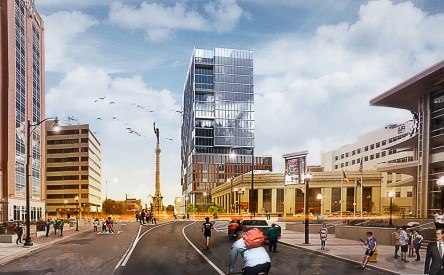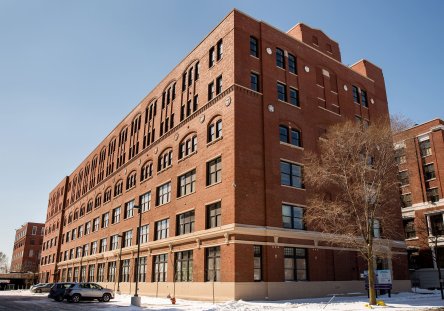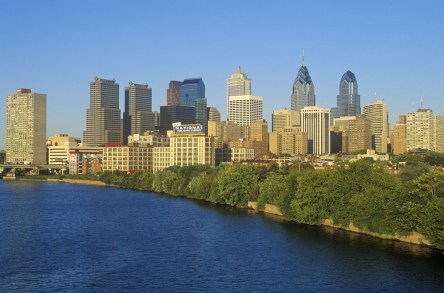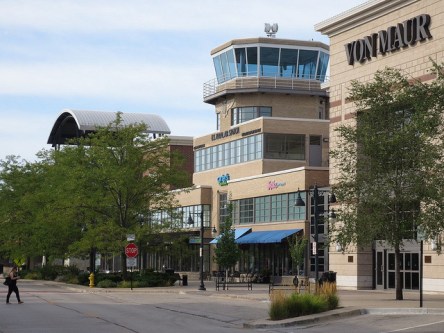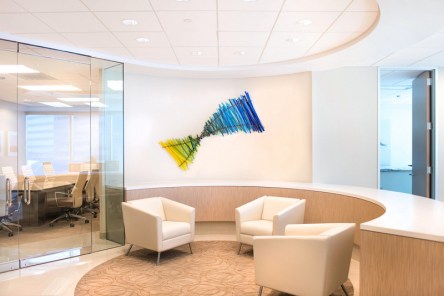Desperate times call for creative solutions. The city of Allentown, Pennsylvania faced a multimillion-dollar deficit, high crimes rates, and a dwindling population. A unique approach to capital investment saved the city, producing what the mayor calls “Allentown 4.0.” William Billowitch, Controller, City Center Investment Corporation, sits down with Yardi to explore the organization’s singular approach to development. Built from Necessity The city of Allentown, the third largest city in Pennsylvania, descended into a rut during the recession. Its blighted neighborhoods became a hotbed for crime. While neighboring cities gradually pulled out of their recession lows, Allentown continued to descend. In the effort to save the town, local leaders and visionaries from the public and private sector worked together to draft a revitalization plan for the urban core. With that plan in mind, real estate development firm City Center Investment Corporation created City Center Lehigh Valley. The mixed-use complex is helping to transform downtown Allentown into one of America’s most vibrant urban communities. It is a regional center of excellence for business, culture and metropolitan living. “Our objective is to stimulate downtown, the economy. We use pretty much almost all Pennsylvania labor, all Pennsylvania products, to build,” says Billowitch. With Allentown’s new arena, PPL Center, at its core, City Center includes more than 1 million square feet. The campus includes three Class A office towers, the Renaissance Allentown Hotel, STRATA East and West residential buildings, The Shops at City Center, upscale restaurant space and a co-working space called Velocity. The seven-story office building, One City Center, was the first installment of a 10-year master planned project. In addition to office space, it is home to a sports performance and fitness center. One City Center is currently fully leased. “Since then, we’ve opened a building every...
Western Focused
LocalConstruct Grows + Thrives
Casey Lynch and Mike Brown were graduate school classmates at UCLA when they started their real estate investment and development company, LocalConstruct, with limited funds and bona fide sweat equity. “We bought a $55,000 condominium in Fontana, Calif. that we painted and renovated ourselves. We were at Home Depot, buying our own supplies,” recalled Lynch. Flash forward nearly a decade, and LocalConstruct has become a thriving small firm with multifamily and mixed-use projects in California, Colorado, Idaho and Montana. The Los Angeles-based company, a Yardi client, has developed 2,000 apartment units to date. Lynch and Brown have a specific vision for urban infill development. Seeking out markets with plentiful jobs but limited work-proximate housing, they have hit a sweet spot where limited supply meets unprecedented demand. We talked with Lynch about LocalConstruct’s market choices and formula for success. You started your company in 2008, when real estate was in a desperate place. Why? Lynch: We saw a great opportunity to start an entrepreneurial enterprise, given the volatility in the market at the time. We raised a small fund to go out and buy single family homes and convert them into real properties in Los Angeles. You always hear developers who have been in the business 30 to 40 years talk about their first deal and working their way up the ladder. For us and our story, that would be true. Things have changed tremendously since then. What happened to LocalConstruct in the last nine years? Lynch: We went from one unit projects to 2 to 4 to 8 to 20 to 100 to 300. We have a presence in four states in the West and we are focused on infill housing strategies, primarily rental housing, and we are focused on emerging markets...
Sears HQ Repurposed
Historic, Affordable Housing
In the United States, the dire need for affordable housing continues. The nation currently faces a deficit of 7.4 million affordable units for those earning less than 30 percent of the local median income. In an effort to develop inexpensive housing in desirable areas, numerous project developers have opted to repurpose existing buildings. Bloomberg reports the account of one such property that is 112 years in the making. Sears Reborn On the West Side of Chicago sprawls more than 1 million square feet of American history. Constructed in 1905, the site served as the original Sears headquarters. It includes a 14-story clock tower, a printing plant, and several additional buildings. Sears occupied the site for 70 years before relocating to its most iconic Chicago home. The site began a slow and unsteady decline, accentuated with failed projects and abandoned spaces. In 2014, Yardi client Mercy Housing Lakefront embarked on a new project at the site, Lofts at Arthington. It would be an affordable housing community that consists of 181 units and on-location social services. Residents would have access to childcare, public transit, and job opportunities in nearby Chicago proper. “We were in a position to come and build affordable housing in a neighborhood with more amenities than more upscale neighborhoods could only dream of,” says Mark Angelini, President of Mercy Housing Lakefront. The redevelopment cost about $55 million. Lofts at Arthington qualified for federal historic preservation tax credits through the National Park Service. It also received low-income housing tax credits from the U.S. Department of Housing and Urban Development. One-third of the units are allotted for residents who earn less than 30 percent of the local median income. The remaining two-thirds have an income cap that is 60 percent of the local median income....
NFL’s Hollywood Park...
Kickoff for Mixed Use
Designer HKS and developer Hollywood Park Land Company are changing the face of mixed-used facilities. The duo behind the Hollywood Park complex will tap into several revenue streams with a built-in consumer base. After more than a decade of anticipation, the 238-acre Hollywood Park project is finally underway with gusto. Ground broke back in 2014. It stalled and crawled until 2016. This year ushered in new developments. Revenue 1: Mixed-Use Commercial & Residential The 3 million square foot mixed-use property will include 620,000 square feet of retail space, and an unconfirmed quantity of townhomes and apartments, and a luxury hotel with stunning city views. Residents and guests will also have access to a new casino. The former Hollywood Park Casino will be demolished this October and replaced with an 110,000 square-foot facility. The JCJ Architecture design will include 125 card game tables, simulcast wagering, a lounge, a café, and a Century Bar & Grill sports bar. “This new casino was also designed with luxury and convenience in mind,” said Hollywood Park Casino General Manager Deven Kumar in a press release. “The new property will engage the art and social communities featuring global artists’ work throughout. […] Visitors will feel very safe, while enjoying themselves in beautiful surroundings.” Revenue 2: Creative Commercial Spaces To soften the edges of the manmade structures, designers added several green spaces throughout the site. A lake with water features will help to create a cool and calming vibe. These parks can provide rental opportunities for arts and cultural organizations; spaces for vendors with kiosks; and even creative advertising installations for landscaping, home and exterior furnishing companies. The stadium project is slated for completion in 2019 followed by the casino and “mini-city” in 2023. Revenue 3: NFL Gold Two sports teams...
East End Revitalized
Richmond Redevelopment & Housing
Yardi client Richmond Redevelopment and Housing Association (RRHA) recently broke ground on the expansive Churchill North/East End Revitalization project. East End Revitalization will include the demolition of the 504-unit Creighton Court public housing community. It will be replaced with a mixed-income community of nearly 1,000 energy efficient homes and apartments. Residents can choose between more than 40 townhomes, 240 market rate rentals, and public housing. The new neighborhood will include more than 500 public housing units to replace those demolished at Creighton Court. All units will be converted to the U.S. Department of Housing and Urban Development (HUD) Rental Assistance Demonstration program. The vacant Armstrong High School, the site of the project groundbreaking, is also being demolished. Upon completion, the 21-acre site will receive infrastructure redevelopment in preparation for housing. Construction may take a decade or longer to complete but the momentum and enthusiasm are growing. Mayor Jones says, “From this building will rise a phoenix of new possibility and transformation of persons who will be able to have better lives and better environments to live in.” Tammy Grubb, Housing Choice Voucher Program Supervisor with RRHA shares the Mayor’s enthusiasm. “We’re revitalizing the entire corridor,” she says. “We’re looking forward to a beautiful transformation. We’re so excited about the new housing. For Grubb, the housing is more than a shelter. She sees the new homes as stepping-stones towards a brighter future. “It’s like our mission at Richmond Redevelopment, to assist in finding housing, to encourage our clients who use housing as a stepping stone to build themselves up and take advantage of the programs that they need to step up and become more self-sufficient.” “We are also excited for the new opportunities that residents will have, personally and professionally,” says Grubb. The highly anticipated...
Crest Manor
Addressing Affordable Housing
Redevelopment and new construction at Crest Manor apartments in Willow Grove, Pa., began on April 13, 2016. The new construction will provide subsidized housing to the state with one of the most significant shortages. Montgomery County Housing Authority (MCHA) constructed the 54-year-old property. The need for updates and repairs for the two-story buildings became critical: one residential building and a maintenance building will be demolished; 15 residential buildings will undergo substantial rehabilitation; three new residential buildings and a new community center will be constructed at the 4.48-acre site. The reimagined community will feature 46-units of affordable housing apartments and duplexes. The homes range from one- to five-bedroom floorplans. MCHA partnered with Yardi client Pennrose Properties, LLC and Pennrose Management Company for the nearly 50,000 square-foot revitalization project. “This redevelopment was a true community partnership,” said Kyle Speece, senior developer, Pennrose Properties, LLC. “MCHA was truly vested in understanding the needs and wants of current Crest Manor residents, as well as other stakeholders in the community.” The new construction will provide much needed housing for the state. A study from the National Low Income Housing Coalition reveals that the average workers in Pennsylvania cannot pay rent based on their current salaries. Rising wages have not kept up with skyrocketing rents. A Pew Research Center report estimates that 21 million Americans are struggling to pay for housing with near minimum wage salaries. The wage-to-rent gap is markedly large in Pennsylvania. The Atlantic’s City Lab observes that Pennsylvania residents are among the most likely in the country to get priced out of rental housing. The new additions at Crest Manor are a small step in the right direction. The Crest Manor community revitalization required $17.7 million in funding. Alden Torch Financial/JPMorgan Chase contributed $12.4 million in equity...
Military Bases, Reimagined...
Base Conversions Offer High Yields
Upcoming military base closures will provide a wealth of opportunities for developers. Beginning in the early 1990s, more than 8,000 military installations in Western Europe and North America shut their doors, according to NATO Review. In the US, 97 facilities were shuttered, resulting in land sales upwards of 100,000 acres and thousands of buildings. With plans for the US Army to reduce its forces to 500,000 soldiers by the end of 2015, bases are bracing for 70 additional decommissioned sites. Developers can begin to prepare their bids. The first wave of closures in the early 90s was low-hanging fruit for development firms. Land prices were low, which made achieving a healthy ROI faster and easier. National Real Estate Investor (NREI) reports average returns of 8-10 percent in the first year on bases that are repurposed as office or industrial spaces. Such successes are now more difficult to replicate, but they are far from impossible. Nearing the new millennium, the Department of Defense (DOD) began seeking higher prices for prime locations. For example, a 4,700 site outside of Orange County has an estimated sale value of $1 billion—which is more than the DOD gained from the sales of 96 previous bases. Developers interested in the new wave of closures will have to bring much more to the table. In spite of the rising prices, military base conversions are still lucrative. According to Builder Online, the former Glenview Naval Air Station is being transformed into the master planned community, the Glen. This 1,200-acre site rests just outside of Chicago. It includes single-family and multifamily housing, retail, and green space. The complex has experience such success that it is expanded into another project. The most recent addition, Westgate on the Glen, is under development. Upon completion, it...
Property Enhancement
Adding color and efficiency
The real estate environment is in constant evolution, changing and adapting to accommodate the needs of a diversified pool of customers. To stay on top of the game, investors are constantly looking for the right mix of ingredients to ensure asset performance; more often, it’s a blend of creativity, sustainability and innovation that helps deliver the best results. Enhancing interiors through art. Parmenter Realty Partners, a real estate investment, management and development company headquartered in Miami, Florida, has found art as a most appropriate means to add color and appeal to their properties. With the help of two local artists and their inspiring creations, Parmenter aims to breathe new life into one of their most recent acquisitions in Dallas, Texas. The lobby of Rambler Park (pictured, right), a 14-story, 310,771-square-foot office building at 7557 Rambler Road, is now home to exquisite artwork installations by Mark Whitmarsh and Carlyn Ray. “When we acquired this beautiful building, the gallery-like lobby was missing some much needed color,” said Josh Hedderich, Asset Manager for Parmenter Realty Partners. “The addition of the work by artists as talented as Mark and Carlyn adds an upgraded dimension to the building, which we hope will delight and intrigue our tenants.” Three of Whitmarsh’s pieces are currently on display, including “Fall Thunder,” “Blue Odyssey,” and “Dream Sequence.” The artist is highly appreciated and admired for his abstract expressionistic use of color and creating high-energy vivid stories on the canvas. He has lived and painted in Dallas for more than 20 years. Carlyn Ray, a local glass blower and former Dale Chihuly understudy, has created a unique glass weave light sculpture that gives the building’s lobby a contemporary yet relaxing feel. During her two years as an employee for Chihuly, Ray was part of...
Saving the Cities
The rewards of revitalization
Philadelphia, Detroit, Cleveland, Atlanta—these major U.S. cities top data lists as the slowest to recover from the recession. Their areas of weakness include high unemployment rates, failing businesses, job losses, crime, and strained budgets but a greater common theme unites them. The cities are too historic, too important, to fail. Restoring these iconic cities to their former glory—or better, propelling them towards an even brighter future—requires a significant amount of creativity. Community leaders are forming dynamic partnerships with local businesses and governments. The collaborations aim to revitalize America’s cities, breathing new life into them through arts education, community programming, and structural reimagining. Two programs in Atlanta are an excellent illustration of the sort of creative approaches that can make a notable difference. LaShawn Hoffman, CEO of Pittsburgh Community Improvement Association (PCIA) in Atlanta, has been a member of the Pittsburgh community for ten years. The neighborhood, first overlooked during the city’s 1996 Olympic revitalization efforts and then hit hard during the housing market downturn, had settled into a state of neglect. Abandoned homes and empty storefronts opened the gate to increased crime and a lack of community cohesion. Hoffman witnessed multiple break-ins and other crimes firsthand. He was determined to witness the neighborhood’s restoration firsthand as well. “This is my home,” he says. “I’m personally invested here and I’ve long been able to see its potential.” PCIA purchased 31 bank-owned homes in Pittsburgh using funds from the Neighborhood Stabilization Program. After restoring the homes, additional local grants were used to give the properties eco-friendly updates. The renovated properties were then placed back on the market at affordable prices. Though it was an excellent start towards giving the neighborhood a face lift, Hoffman and his team knew that pretty houses would not address the root...

